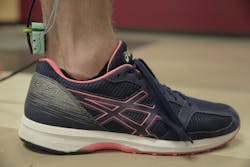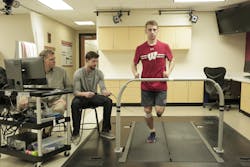New Wearable Device Tracks Muscle Movements
Even though today we can easily measure external forces during movement, we still lack the ability to measure the underlying muscle-tendon forces that generate human movement. Previous measuring methods have provided only limited information on the human tendons and muscles. Fortunately, new wearable device technology and research from the University of Wisconsin-Madison (UW-Madison)—led by mechanical engineering professor Darryl Thelen and graduate student Jack Martin—have determined a new non-invasive method of measuring human muscle-tendon force and movement.
Previous animal studies have used surgically implanted force sensing to gain insights into the control and mechanics of muscle-tendon. However, the invasiveness of the implanted sensor did not offer much practical benefit to human study. Prior attempts to non-invasively track muscle and tendon forces in humans was based on wave propagation measures.
For example, the speed of the axial sound waves, or compression waves, in the tendon vary with different loading conditions during movement. Sound wave propagation is controlled by tissue elasticity. The sound wave speed primarily provides a metric tissue of stiffness rather than force. Shear wave speed also increases depending on the load in the muscle and tendon. However, this dependency is typically related to the strain-stiffening increase in the tissue’s shear modulus. Current ultrasonic shear wave measurement systems lack the range and temporal resolution for tracking issue wave speeds during each dynamic movement.
In vivo ultrasonic measurement of wave speed. Image A shows a linear array ultrasound transducer was strapped over the subject’s Achilles tendon. A high frame rate, 14,100 frames per second of ultrasonic radiofrequency (RF) data, was collected at two points (red, blue lines). A custom tapper device, which was located distal to the ultrasound transducer, intermittently induced transverse waves in the tendon. Transverse tissue velocity was measured at multiple kernels (indicated by boxes; darker shades indicate greater depth) located along each RF collection line (red, blue). Scale bar, 1 cm. In image B, we observed that transverse motion was similar for all kernels along the first (red, lower) and second (blue, upper) measurement locations. Thus, tendon wave motion could conceivably be measured from the motion of subcutaneous tissue. (Image credit: UW-Madison)
The researchers at UW-Madison introduced a new way to track and interpret tendon shear wave speeds during dynamic movement. The team’s recent paper, published in April in the Nature Communications journal, establishes how the team approached this new concept. The researchers first started with a tensioned beam model and ex-vivo measurements. This was to show that shear wave propagation speed in tendons depend primarily on the axial stress at physiological loads. This reflects the tension-dependent vibration frequencies of a string, like the ones found in a guitar.
The team then went on to demonstrate how in vivo tendon wave speeds can be dynamically tracked using a simple shear wave tensiometer. The tensiometer consists of a skin mounted tapping device and miniature accelerometer. This new system is portable and inexpensive.
The mechanical device taps the tendon 50 times per second, with each tap initiating a wave in the tendon. The lower extremity tendon wave speeds are shown to vary closely with the joint kinetics during active movements, and it also detects phases of passive tendon tensioning. These passive tensions have only been detectable in the past with surgically installed invasive sensors.
The system developed by mechanical engineering professor Darryl Thelen and graduate student Jack Martin includes a mechanical device that lightly taps the tendon 50 times per second. (Image credit: Renee Meiller/UW-Madison)
The research team have used the system to measure forces not only on the Achilles tendon, but also the forces found at the patellar and hamstring tendons. By measuring the forces and how the muscles and tendons behave within the human body, the system developed by the research team will enable doctors and medical facilities to plan more effective treatments for patients dealing with musculoskeletal disease and injuries.
“We think the potential of this new technology is high, both from a basic science standpoint and for clinical applications,” Thelen says. “For example, tendon force measures could be used to guide treatments of individuals with gait disorders. It may also be useful to objectively assess when a repaired tendon is sufficiently healed to function normally and allow a person to return to activity. This technical advance can also address many important applications spanning orthopedics, rehabilitation, ergonomics, and sports.”



